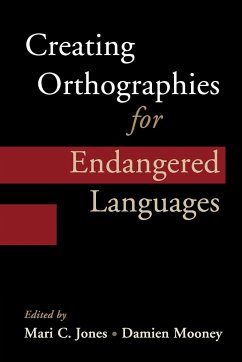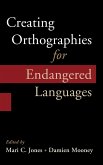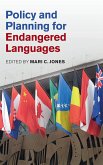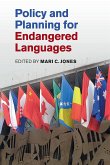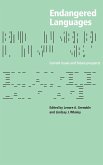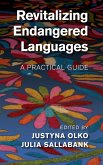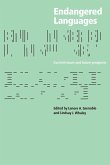Creating Orthographies for Endangered Languages
Herausgeber: Jones, Mari C.; Mooney, Damien
Creating Orthographies for Endangered Languages
Herausgeber: Jones, Mari C.; Mooney, Damien
- Broschiertes Buch
- Merkliste
- Auf die Merkliste
- Bewerten Bewerten
- Teilen
- Produkt teilen
- Produkterinnerung
- Produkterinnerung
This volume discusses how orthographies are being developed and used in the specific context of language endangerment and revitalisation.
Andere Kunden interessierten sich auch für
![Creating Orthographies for Endangered Languages Creating Orthographies for Endangered Languages]() Creating Orthographies for Endangered Languages90,99 €
Creating Orthographies for Endangered Languages90,99 €![Policy and Planning for Endangered Languages Policy and Planning for Endangered Languages]() Policy and Planning for Endangered Languages118,99 €
Policy and Planning for Endangered Languages118,99 €![Policy and Planning for Endangered Languages Policy and Planning for Endangered Languages]() Policy and Planning for Endangered Languages42,99 €
Policy and Planning for Endangered Languages42,99 €![Endangered Languages Endangered Languages]() A. Grenoble / J. Whaley (eds.)Endangered Languages128,99 €
A. Grenoble / J. Whaley (eds.)Endangered Languages128,99 €![Revitalizing Endangered Languages Revitalizing Endangered Languages]() Revitalizing Endangered Languages119,99 €
Revitalizing Endangered Languages119,99 €![Endangered Languages Endangered Languages]() A. Grenoble / J. Whaley (eds.)Endangered Languages67,99 €
A. Grenoble / J. Whaley (eds.)Endangered Languages67,99 €![Endangered Languages and New Technologies Endangered Languages and New Technologies]() Endangered Languages and New Technologies42,99 €
Endangered Languages and New Technologies42,99 €-
-
-
This volume discusses how orthographies are being developed and used in the specific context of language endangerment and revitalisation.
Produktdetails
- Produktdetails
- Verlag: Cambridge University Press
- Seitenzahl: 344
- Erscheinungstermin: 2. April 2020
- Englisch
- Abmessung: 229mm x 152mm x 19mm
- Gewicht: 499g
- ISBN-13: 9781316602584
- ISBN-10: 1316602583
- Artikelnr.: 59365187
- Herstellerkennzeichnung
- Libri GmbH
- Europaallee 1
- 36244 Bad Hersfeld
- gpsr@libri.de
- Verlag: Cambridge University Press
- Seitenzahl: 344
- Erscheinungstermin: 2. April 2020
- Englisch
- Abmessung: 229mm x 152mm x 19mm
- Gewicht: 499g
- ISBN-13: 9781316602584
- ISBN-10: 1316602583
- Artikelnr.: 59365187
- Herstellerkennzeichnung
- Libri GmbH
- Europaallee 1
- 36244 Bad Hersfeld
- gpsr@libri.de
1. Introduction Mari C. Jones and Damien Mooney; 2. Who owns vernacular
literacy? Assessing the sustainability of written vernaculars Christopher
Moseley; 3. Hearing local voices: creating local content participatory
approaches in orthography development for non-dominant language communities
Mansueto Casquite and Catherine Young; 4. Orthographies 'in the making':
the dynamic construction of community-based writing systems among the
Náayeru of north-western Mexico Margarita Valdovinos; 5. Community-driven
goal centred orthography development: a Tsakhur case study Kathleen D.
Sackett; 6. Writing for speaking: the N uu orthography Sheena Shah and
Matthias Brenzinger; 7. Reflections on the Kala Bi¿atuwä, a three-year-old
alphabet, from Papua New Guinea Christine Schreyer; 8. When letters
represent more than sounds: ideology vs practicality in the development of
a standard orthography for Ch'orti' Mayan Kerry Hull; 9. The difficult task
of finding a standard writing system for the Sioux languages Avelino Corral
Esteban; 10. Orthography development in Sardinia: the case of Limba Sarda
Comuna Rosangela Lai; 11. Breton orthographies: an increasingly awkward fit
Steve Hewitt; 12. Spelling trouble: ideologies and practices in Giernesiei
/ Dgernesiais / Guernesiais / Guernésiais / Djernezié. . . Julia Sallabank
and Yan Marquis; 13. Orthography development on the Internet: Romani on
YouTube D. Viktor Leggio and Yaron Matras; 14. Is orthography creation
unavoidable for postvernacular languages? Case studies of Rama and
Francoprovençal revitalization Bénédicte Pivot and Michel Bert; 15.
Changing script in a threatened language: reactions to Romanization at
Bantia in the first century BC Katherine McDonald and Nicholas Zair.
literacy? Assessing the sustainability of written vernaculars Christopher
Moseley; 3. Hearing local voices: creating local content participatory
approaches in orthography development for non-dominant language communities
Mansueto Casquite and Catherine Young; 4. Orthographies 'in the making':
the dynamic construction of community-based writing systems among the
Náayeru of north-western Mexico Margarita Valdovinos; 5. Community-driven
goal centred orthography development: a Tsakhur case study Kathleen D.
Sackett; 6. Writing for speaking: the N uu orthography Sheena Shah and
Matthias Brenzinger; 7. Reflections on the Kala Bi¿atuwä, a three-year-old
alphabet, from Papua New Guinea Christine Schreyer; 8. When letters
represent more than sounds: ideology vs practicality in the development of
a standard orthography for Ch'orti' Mayan Kerry Hull; 9. The difficult task
of finding a standard writing system for the Sioux languages Avelino Corral
Esteban; 10. Orthography development in Sardinia: the case of Limba Sarda
Comuna Rosangela Lai; 11. Breton orthographies: an increasingly awkward fit
Steve Hewitt; 12. Spelling trouble: ideologies and practices in Giernesiei
/ Dgernesiais / Guernesiais / Guernésiais / Djernezié. . . Julia Sallabank
and Yan Marquis; 13. Orthography development on the Internet: Romani on
YouTube D. Viktor Leggio and Yaron Matras; 14. Is orthography creation
unavoidable for postvernacular languages? Case studies of Rama and
Francoprovençal revitalization Bénédicte Pivot and Michel Bert; 15.
Changing script in a threatened language: reactions to Romanization at
Bantia in the first century BC Katherine McDonald and Nicholas Zair.
1. Introduction Mari C. Jones and Damien Mooney; 2. Who owns vernacular
literacy? Assessing the sustainability of written vernaculars Christopher
Moseley; 3. Hearing local voices: creating local content participatory
approaches in orthography development for non-dominant language communities
Mansueto Casquite and Catherine Young; 4. Orthographies 'in the making':
the dynamic construction of community-based writing systems among the
Náayeru of north-western Mexico Margarita Valdovinos; 5. Community-driven
goal centred orthography development: a Tsakhur case study Kathleen D.
Sackett; 6. Writing for speaking: the N uu orthography Sheena Shah and
Matthias Brenzinger; 7. Reflections on the Kala Bi¿atuwä, a three-year-old
alphabet, from Papua New Guinea Christine Schreyer; 8. When letters
represent more than sounds: ideology vs practicality in the development of
a standard orthography for Ch'orti' Mayan Kerry Hull; 9. The difficult task
of finding a standard writing system for the Sioux languages Avelino Corral
Esteban; 10. Orthography development in Sardinia: the case of Limba Sarda
Comuna Rosangela Lai; 11. Breton orthographies: an increasingly awkward fit
Steve Hewitt; 12. Spelling trouble: ideologies and practices in Giernesiei
/ Dgernesiais / Guernesiais / Guernésiais / Djernezié. . . Julia Sallabank
and Yan Marquis; 13. Orthography development on the Internet: Romani on
YouTube D. Viktor Leggio and Yaron Matras; 14. Is orthography creation
unavoidable for postvernacular languages? Case studies of Rama and
Francoprovençal revitalization Bénédicte Pivot and Michel Bert; 15.
Changing script in a threatened language: reactions to Romanization at
Bantia in the first century BC Katherine McDonald and Nicholas Zair.
literacy? Assessing the sustainability of written vernaculars Christopher
Moseley; 3. Hearing local voices: creating local content participatory
approaches in orthography development for non-dominant language communities
Mansueto Casquite and Catherine Young; 4. Orthographies 'in the making':
the dynamic construction of community-based writing systems among the
Náayeru of north-western Mexico Margarita Valdovinos; 5. Community-driven
goal centred orthography development: a Tsakhur case study Kathleen D.
Sackett; 6. Writing for speaking: the N uu orthography Sheena Shah and
Matthias Brenzinger; 7. Reflections on the Kala Bi¿atuwä, a three-year-old
alphabet, from Papua New Guinea Christine Schreyer; 8. When letters
represent more than sounds: ideology vs practicality in the development of
a standard orthography for Ch'orti' Mayan Kerry Hull; 9. The difficult task
of finding a standard writing system for the Sioux languages Avelino Corral
Esteban; 10. Orthography development in Sardinia: the case of Limba Sarda
Comuna Rosangela Lai; 11. Breton orthographies: an increasingly awkward fit
Steve Hewitt; 12. Spelling trouble: ideologies and practices in Giernesiei
/ Dgernesiais / Guernesiais / Guernésiais / Djernezié. . . Julia Sallabank
and Yan Marquis; 13. Orthography development on the Internet: Romani on
YouTube D. Viktor Leggio and Yaron Matras; 14. Is orthography creation
unavoidable for postvernacular languages? Case studies of Rama and
Francoprovençal revitalization Bénédicte Pivot and Michel Bert; 15.
Changing script in a threatened language: reactions to Romanization at
Bantia in the first century BC Katherine McDonald and Nicholas Zair.

